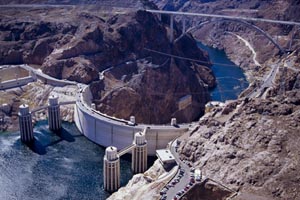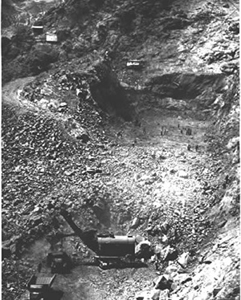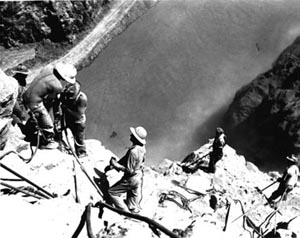
Hoover Dam stores water that irrigates 2 million acres, not only in the rich farm fields of Southern California’s Imperial Valley, but across the state line in Arizona. Hoover Dam generates enough hydroelectric power to serve 1.3 million people each year, provides municipal water for urban centers including Los Angeles, Phoenix and Tucson, holds back flood waters, provides storage during drought and takes more than a little credit for the unabashed growth of the desert Southwest. For all that, Hoover Dam is much more; it is an American icon, a monument to the ingenuity of the nation’s engineers and the power of its machines. Hoover Dam is the symbol of an era when an urban, industrial America reveled in harnessing its natural resources.
The story of Hoover Dam begins long before the first bucket of concrete was poured on June 6, 1933, and it continues today with the recently opened Hoover Dam Bypass Bridge, an engineering marvel in itself, towering 900 feet above the Colorado River’s Black Canyon, just south of Hoover Dam. The new bridge diverts traffic from the top of the dam, lessening congestion and increasing security, while also offering unsurpassed views from its pedestrian walkway. Hoover Dam, spanning the Arizona-Nevada border about 30 miles southeast of Las Vegas, is the most-visited dam in the world, counting some 7 million tourists a year. With its 110-mile-long Lake Mead, Hoover Dam and its corresponding system of tunnels, outlet works, spillways, powerplant, and transmission lines has transformed this bone-dry slice of desert into a vacation paradise.
As early as 1901, manmade canals diverted Colorado River water to the Imperial Valley’s fruit and vegetable fields. But the Colorado was a mighty river, gouging rock mesas as it went, including the most famous gorge of all--the Grand Canyon. The Colorado could grow angry, swelling to a torrent, flooding land for miles around, clogging irrigation canals with sediment, and washing away small earth dams. In 1905, the Colorado broke out of its banks at an irrigation canal head works and ran wild for months, sending its entire flow into the Salton Sink--creating the Salton Sea. As the Colorado destroyed homes and crops, and damaged highways and railroads, its name turned to mud, much like the landscape it destroyed.
To engineers at the U.S. Bureau of Reclamation, the solution was clear: a large, multipurpose dam that not only would control floods, but harness the Colorado for irrigation and hydroelectric power. Years of debate followed as opponents questioned the economic feasibility and engineering know-how for such an enormous project. Furthermore, six of the seven states in the Colorado River drainage area (Colorado, Wyoming, Utah, New Mexico, Arizona, and Nevada) expressed fears that California would get the lion’s share of the water. Then-Secretary of Commerce Herbert Hoover stepped up as the man of the hour when he oversaw a compromise in 1922 that became the Colorado River Compact. This compact divided the seven states into the Upper and Lower Basins, established a set amount of river water to be consumed annually, and left the apportionment percentages for the states to work out among themselves.
On December 21, 1928, President Calvin Coolidge signed an act authorizing the Boulder Canyon Project, so named because a study originally had recommended the Boulder Canyon of the Colorado, not the nearby Black Canyon, as the site of the dam. On July 3, 1930, then-President Herbert Hoover signed the first appropriation bill. It was during dedication ceremonies on September 17, 1930, that Secretary of the Interior Ray L. Wilbur, while driving a silver spike for the railroad spur that would run to the construction site, announced that the name of the colossal structure was to be Hoover Dam. However, the soon-to-be-elected Democratic administration of Franklin Roosevelt continued to use the name Boulder Dam. It wasn’t until April 30, 1947, that a resolution of Congress made Hoover Dam the official name.

Building Hoover Dam was a monumental undertaking. Construction required 5 million barrels of cement and 45 million pounds of reinforcement steel. The mass of concrete used weighed 6.6 million tons and would pave a road stretching from San Francisco to New York City. Hoover Dam’s spillways could float a battleship, and Lake Mead, when filled to capacity, contains enough water to cover Connecticut 10 feet deep. It would take a maximum of 5,218 men (employed in any one month) a total of five years to build the dam, which actually was completed ahead of schedule. The construction contract went to a combination of six prominent contracting firms that pooled their resources and incorporated as Six Companies Inc. of San Francisco, for the express purpose of building Hoover Dam. Six Companies’ low bid of nearly $49 million, awarded on March 11, 1931, was the largest construction contract let by the U.S. government up to that time.
Housing and feeding workers was a huge task, as well. The government designed and built the still thriving Boulder City, six miles from the dam site. A state-of-the-art hospital anticipated the many injuries to come (the official death toll is 96 men), while a fully stocked department store, recreation hall, laundry, and amenities from a school to a post office rounded out the town. Married men and their families lived in 758 cottages, while single men lived in one of nine dormitories. The men paid $1.60 a day for room and board at the domitories, but they received a private room, transportation to and from the construction site, and all-they-could-eat meals. Beef, veal, lamb, and pork came in 20,000-pound lots shipped from Reno. With no dairies in southern Nevada, Boulder City’s food contractor purchased a 160-acre farm at Mesquite, Nevada, where 200 cows provided fresh milk, cream, and butter.
Less wholesome was the road to Vegas, where bars and brothels sprang up miles before the workers with pay in their pockets could make it to what in the 1930s was a Las Vegas of only 5,000 people. While gambling had existed illegally there for years, the town secured a legal thumbs up from the Nevada Legislature in 1931, the same year construction began on Hoover Dam. While gambling was legal, drinking was not. In Boulder City, officers seized eight stills and arrested 72 people before Prohibition was repealed in early 1933.
So how does one go about building a dam as large as Hoover?
First, engineers had to find a way to turn the mighty Colorado River aside so workers could have access to a dry river bed. They did this by driving four tunnels through the canyon walls, two on each side, the intent being to funnel the river past the dam site, then shoot it out below. With temperatures reaching as high as 140 degrees in the tunnels, workers suffered from deadly heat prostration, with a reported death of one worker occurring every two days in the summer of 1933. Not only did the tunnels need to be dug, but also lined with concrete and then grouted to fill any seams or cracks. The sun-scorched desert heat was intense in the open air, as well, where 115 degrees during the day and a low of 95 at night were common during the summer months. Tunnel excavation using traditional drill-and-blast methods proceeded for more than two years, from June 1931 to November 1933.
When two of the tunnels were finished, excavated rock and gravel were dumped into the river to form a temporary coffer dam, which began diverting the Colorado’s flow into those tunnels on November 14, 1932. Permanent coffer dams were then built, one upstream (98 feet high and 510 feet long) and one downstream (66 feet high and 350 feet long). The “construction stiffs,” as Fortune magazine referred to the workers, now were free to attack the canyon walls. Making an average 68 cents an hour, they were lowered over the canyon rim in safety belts or bosun chairs, then used steel bars to knock down any and all loose material, and 44-pound jackhammers to drill powder holes. By the summer of 1933, so many “high scalers,” as they were known, had been killed by rock slides and falling objects that the men took to making improvised hard hats by coating their cloth hats with coal tar, which proved extremely effective.
With water diverted and the river bed dry, excavation began for the dam, the powerplants that sit at its toe, and the twin set of graceful intake towers, which stand prominently on the reservoir side of the dam. Using huge power shovels, men labored in shifts, 24 hours a day, removing mud, silt, and rock to reach solid bedrock. Abutments had to be shaped properly and cuts made in the canyon walls to ensure the dam could carry the forthcoming load of more than 41 billion tons.

Finally, work on the actual dam could begin. Because engineers wanted a single mass, the design called for a series of an estimated 215 vertical columns. The columns were constructed block by block by pouring concrete into square forms varying in size from 25 to 60 feet square. Each block interlocked with the next by vertical and horizontal keyways, like a Lego set. Hoover Dam is a concrete arch-gravity dam, meaning, as explained by the Public Broadcasting Service website “Building Big,” that as tons of water in the reservoir push against the concrete in the dam, compressive forces travel along the dam’s great wall into the cliffs on both sides of the dam.
Because concrete creates great internal heat while hardening, Hoover Dam’s engineers worried about expansion and then contraction of the concrete. To solve the problem they created an artificial cooling system consisting of 590 miles of pipe loops embedded in the concrete with air-cooled or refrigerated water circulating through them. Buckets of concrete, mixed at two plants onsite and transported by rail, were hoisted by one of five, 20-ton cableways strung from canyon rim to canyon rim. During the summer, as each section was poured, it was the sole task of 20 men to keep the concrete moist by spraying the surface with water. Thus was Hoover Dam built, concrete block upon concrete block, the last bucket poured on May 29, 1935. That February 1, even before the last bucket was poured, water began to back up into Lake Mead when a great steel bulkhead in one of the diversion tunnels was lowered.
Today, as then, electrically operated hoists atop the intake towers raise and lower gates below, drawing water in from the reservoir. The water rushes in through headers and down huge pipes called penstocks to the powerhouse, where water flowing at the rate of 2,000 to 3,000 cubic feet per second operates the 17 main turbines that spin the generators that create electricity.

Combined with the penstocks, a series of pipes known as the outlet system can bypass the turbines and divert water into the river channel downstream if an emergency warrants or if the penstocks need maintenance. In June 1998, a torrent of water shot from the outlet system and sent whitecaps rippling down the Colorado during testing of new jet flow gates that replaced 12 obsolete needle valves in the outlet works. The new gates increased the release capacity from about 50,000 cubic feet per second to 73,000 cubic feet per second. (One cubic foot equals about 7½ gallons.)
In addition, two spillways, 27 feet below the top of the dam, stand ready to send any water reaching that high into tunnels that connect to two of the original diversion tunnels.The other two original diversion tunnels, plugged at strategic points, play a key role, as well, in funneling water to the generators in the powerhouse and to the outlet system. Water never has gone over the top of Hoover Dam, nor is it supposed to, and the spillways have only been used twice. The first time, in 1941, was a test of the system. The second time, in 1983, was during a flood.
Visit the National Park Service Travel Bureau of Reclamation's Historic Water Projects to learn more about dams and powerplants.
Last updated: November 7, 2018
